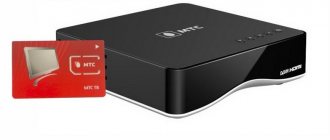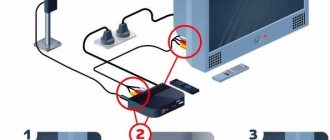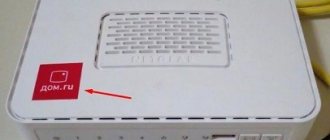Mobile operators regularly expand the list of services they provide to the population, and many are not limited to tariffs for cell phones. The largest number of proposals comes from operators occupying leading positions in the Russian mobile communications market, among which MTS takes not the least place. This operator has many interesting tariff plans with favorable conditions for telephone calls and mobile Internet use. The provider also provides the opportunity to connect home Internet and television. MTS satellite TV deserves special attention. The service provides access to 190 channels (including 35 in HD) and is available even in the farthest corners of Russia. In addition, MTS includes many interactive services and has solid functionality.
Of course, any service from operators has not only advantages, but also disadvantages. Therefore, when planning to connect to satellite television from MTS, you must first carefully familiarize yourself with the features of this service and its characteristic pitfalls. In this article we will try to explain in as much detail and honestly as possible what MTS satellite TV is, under what conditions this service is provided and how to connect it. In addition, you can read real reviews from other users and share your own opinions.
There is currently a promotion under which satellite TV is available without a subscription fee to everyone with a Smart tariff.
Types of satellite Internet
At the moment, there are only two options for providing access to satellite communications on the domestic market. They differ in the specifics of gaining access; each of them requires special equipment. In addition, satellite communication is the only stable way to get a network connection in the remote corners of the planet, regardless of the type of terrain, landscape and distance from civilization. Suitable for a private house, cottage in the village, regardless of their remoteness.
Despite such obvious advantages, satellite Internet and television remain one of the least common methods of transmitting and receiving data. Basically, satellite communications are used only by subscribers who require complete and absolute independence from terrestrial operators.
Note! Satellite communication is the most autonomous and independent way to gain access to the network.
There are only two common methods of data exchange using satellite communications throughout the world:
- Unilateral. In a particular case, data is received using a satellite, and its transmission takes place using conventional terrestrial communications.
- Double-sided. In this case, both reception and transmission of information takes place using a communications satellite.
The domestic market for home or commercial satellite communications is about two million subscribers. According to statistics, not all of them are located in remote corners of the country. A large part of subscribers are located in the suburbs, where summer cottages are traditionally located.
One-way satellite internet
The method that is most widely used. The work uses the following principle: a satellite channel is used to receive the signal, and any signal transmission is carried out using terrestrial communication networks. According to the description, in this case, it is not enough for the subscriber to have only a satellite data transmission channel, since normal communication requires a connection to a terrestrial wired or wireless Internet operator.
Important! This access scheme is suitable where mobile operators or cable networks are widespread.
As for equipment, almost the same set is required for one-way and two-way communication:
- Satellite dish that comes with the transceiver;
- A special modem for this type of communication;
- Bracket for satellite dish;
- Special coaxial cable;
- A special DVB card is required that processes all received data;
- A special converter is required to convert frequencies.
Equipment for one-way access is smaller in size than for similar two-way access. In addition, there is no need for a sufficiently large and massive transceiver, since data transmission via satellite occurs only in one direction.
The differences also lie in the software, which comes in two types. In the first, the DVB card is a network receiving device, and transmission is carried out through a VPN tunnel. In the second case, special software is used to speed up the acquisition of information.
Pros:
- Relatively high operating speed;
- Inexpensive equipment;
- Smaller size and weight of equipment, which makes it easy and cheap to install;
- Lower cost of subscription fee;
Minuses:
- Heavy dependence on the quality of data transmission to send requests;
- High accuracy and qualifications of the master are required when pointing at the satellite;
- Difficult to use if you have a home network and multiple access points.
Two-way satellite internet
The principle of operation of this method is that only a satellite dish and equipment are needed to transmit and receive a signal. The connection is completely autonomous and independent, unlike a similar one-way connection.
Note! Both sending and receiving of any information is carried out by a satellite dish.
This allows you to use satellite television and the Internet on 95% of the territory of Russia, since satellite communications are available almost everywhere. The two-way connection method is less common and more expensive than the similar one-way connection. It is more used in commercial structures, since all costs are paid off by good signal quality.
The equipment needed to receive the connection is similar to the one-way method, only a converter and DVB card are not required:
- Satellite antenna that goes together with the transceiver;
- Modem for two-way communication;
- Bracket for satellite dish;
- Coaxial cable of the required length.
Important! The MTS operator provides the entire set of equipment for rent. You only need to make the connection by the company’s specialists.
In this case, equipment rental fees will be added to the bill for using the services. You can purchase everything you need yourself, in which case you can only pay for communication services.
Note! For each subscriber who wants to connect to a two-way data transfer method, it is necessary to know all the positive and negative aspects.
Pros:
- Absolute autonomy from any other communication channels and service providers;
- No difficulties in connecting and using.
Minuses:
- The high cost of both the equipment itself and the connection with a subscription fee;
- Large equipment sizes;
- Long delays due to long distances from the satellite to the subscriber’s equipment.
Why do you need to know this?
Several parameters are taken into account when determining the location. In particular, azimuth shows the angle between the direction of interest and north. It is calculated in the direction the clock hand moves. When setting, the rotation of the converter, as well as the angle of inclination of the plate itself, is taken into account. Another parameter is the elevation angle, which determines the angle between the direction to the satellite and the horizon. If this indicator is close to zero, the signal is not received.
Knowing the name of the MTS TV satellite and having its parameters at hand, it is easier to catch and configure the equipment for watching TV or using the Internet. The stability of the signal and its quality depend on the correctness of the available data and the clarity of the settings. In other words, knowing the location of the MTS TV satellite, you will quickly configure the necessary channels and achieve a high-quality picture. Even a slight shift left-right, up-down can lead to deterioration in signal quality or its complete loss.
Is it worth connecting?
The principle of operation of satellite Internet and equipment for connecting it
It is possible to list only those moments that the subscriber will receive as a result of connecting to television and the Internet. And the final choice must be made by the user himself, taking into account the following factors:
- Virtually unlimited access. Using a satellite signal, it is possible to cover up to 100% of the planet's area. Cable or wireless television and the Internet do not provide the user with such extensive coverage in areas with difficult terrain. A good signal is provided even in the most inaccessible areas. In this case, the cost of the monthly fee will be much lower than in the case when it is necessary to pull the cable over long distances.
- TV picture quality. Analog and simple digital television cannot boast such good picture and sound quality. Satellite television can provide absolutely clear images in High Definition 1080i resolution. In addition, many TV channels use high-quality digital sound;
- Lots of TV channels. The subscriber has the opportunity to receive a list of thousands of channels from all over the world in many languages.
- Various topics of the broadcast network. You can choose channels that work only in one area, for example, movies, music, sports, travel. In addition, you can choose your own broadcast package from your favorite TV channels. The user can connect or disable unused or unnecessary channels at any time.
- Additional functions. You can get such interesting functions as pausing the broadcast, recording your favorite movies or programs in memory, rewinding, interactive information and announcements, video games and much more.
- Satellite Internet (WebTV). It is a “television + Internet” type system. In all respects, network access can be compared with cable analogues, and even surpass in terms of speed.
- Radio stations from all over the world. You can listen to thousands of world radio broadcasts and enjoy high-quality sound.
- Price. Definitely, connection, setup and subscription fees for satellite communications are expensive.
Selection of components
There are three types of equipment from MTS TV:
- Interactive console. To unlock the maximum potential of the set-top box, a 3G MTC signal is required. This television has a large number of functions.
- Linear HD set-top box. It is characterized as multifunctional equipment. Comparable to a lot of TVs.
- CAM module. The device is suitable for TVs equipped with a DVB-S tuner. Based on this, we draw conclusions: before purchasing a CAM module, you need to be sure that there is a built-in tuner. Since even new TV models are released without a tuner.
To set up satellite MTS TV, you will need:
- Tools.
- F-connectors in the amount of 2 pieces.
- Bracket to secure the antenna.
- Directly the CAM module with a smart or SIM card. Also a prefix, if the choice is on it.
- Antenna.
- Coaxial cable.
- Converter.
As an additional set, the following may be useful: a divider and a plug. The first is needed when connecting two TVs; its operating range is considered to be from 950 to 2150 MHz.
Communication tariffs
Applications for controlling Wi-Fi networks and monitoring traffic on Androdi
Note! The operator's tariff schedule is very extensive, it all depends on the required package.
There is simply access to satellite television, there is access to the network and everything together. Accordingly, the prices are different. It all depends on the required data transfer speed and the number of television channels. All tariffs, special offers and promotions can be viewed on the operator’s official website.
Often the operator runs promotions and offers special rates. With their help, you can connect for free or at a big discount, and also receive bonuses when you pay a subscription.
What to do if TV from MTS does not work
If the satellite dish is installed incorrectly (incorrect tilt/rotation angle), the signal will be weak or completely absent, try to point the antenna correctly. Check if you have set the initial parameters correctly. Also, make sure there is no interference in order to catch the satellite TV signal from MTS.
If you think that you are doing everything correctly, but there is no signal, or the receiver, CAM module, or other device in MTS is broken, issue a return.
Cost of equipment
Technology for transmitting the Internet through the power grid: equipment and characteristics
All necessary equipment can be purchased independently or rented from the operator. In the first case, the monthly subscription fee will consist only of funds for using the services. In the second case, they will be added to the equipment rental fee.
Note! The connection can be carried out in two ways - by specialists or independently.
The cost of the equipment depends on the connection method. Equipment for the one-way method may cost a little more. But the monthly fee will be less.
On average, a set of equipment costs from 25 to 40 thousand rubles, depending on the manufacturer. You can save money and purchase used equipment yourself, then it will cost from 10 to 15 thousand, depending on the condition.
Choosing a location for installing the antenna
Regardless of the subscriber’s location, you need to determine the satellite’s position using a city map. You can open any application, for example, Double-GIS or Yandex.Maps. Next you need to use the algorithm of actions:
- Measure on the map an azimuth of 137 degrees from North. Thus, the antenna will be directed to the southeast;
- Fix the antenna on the wall of the house so that it is directed in a certain azimuth. It is advisable that there is free space nearby, and that the antenna is not located with the dish facing the neighboring house.
How to connect
Note! The connection can be carried out in two ways - by specialists or independently.
The first method is more priority, since it will ensure that all settings fully comply with the required ones. However, you need to pay to connect. In the second case, you can save money.
Antenna installation
The first step is to choose the most suitable place to install the plate, after which you need to perform the following sequence of actions:
- Using a compass, determine the north direction to which the antenna will be directed;
- Attach the bracket to a flat surface;
- Install the bracket and secure the satellite dish to it;
- Connect the wire to the F-connectors.
Settings
Sequence of steps to configure the antenna:
- First you need to download a special application for your phone called SatFinder.
- In the interface you need to select the ABS2-75E satellite. Its use is very simple, you just need to follow all the instructions. The application will independently calculate and indicate the route to the satellite, and also calculate the required rotation and tilt angles of the dish.
- After this, you need to connect the wire directly to the HD set-top box from the operator.
- A menu will appear in which you need to click on the “Settings” section, then “Antenna Settings”. The system will display the signal strength received by the antenna. If it is weak, then it is necessary to rotate the dish until the maximum quality of data reception is obtained.
What satellite does MTS have?
When connecting MTS satellite TV, you need to know which satellite the company uses for subscribers. This data will be needed for a more accurate search and subsequent setup of television or the Internet.
Name
First, let's look at which satellite MTS TV operates on. From October 18, 2017, the company transferred users to a new device called ABS-2A. It is located in the same orbit as its predecessor ABS 2, but has better parameters. Thus, ABS-2A is a geostationary-type device owned by the Bermudian cellular operator (Asia Broadcast Satellite).
Its function is to provide telecommunications services in Africa, Asia (south and southeast), Russia and other regions. The exact name of the MTS satellite for satellite TV is ABS-2A at 75° East. It is equipped with 48 transponders operating in the Ku-band.
Coordinates and parameters
For high-quality television setup, you need to know exactly the coordinates of the MTS TV satellite and other data. The presence of such information allows you to obtain a stable reception level for 60 or 80 cm dishes.
Options:
- Degree. When setting up, it is important to know at what degree the MTS satellite is located. In this case we are talking about 75 degrees.
- Operator: ABS Satellite.
- Range - Ku.
- Frequency - 54 MHz.
- Characteristics of FEC 5/6 and 3/4.
Knowing the parameters of the MTS TV satellite, there are much fewer difficulties in finding it. The information obtained can be used in special services or applications (we will discuss the configuration features below).











